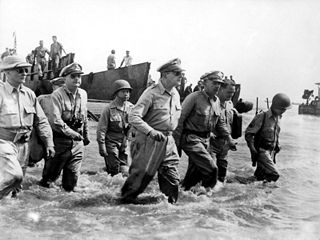
The Battle of Leyte in the Pacific campaign of World War II was the amphibious invasion of the island of Leyte in the Philippines by American forces and Filipino guerrillas under the overall command of General Douglas MacArthur, who fought against the Imperial Japanese Army in the Philippines led by General Tomoyuki Yamashita. The operation, codenamed King Two, launched the Philippines campaign of 1944–45 for the recapture and liberation of the entire Philippine Archipelago and to end almost three years of Japanese occupation.
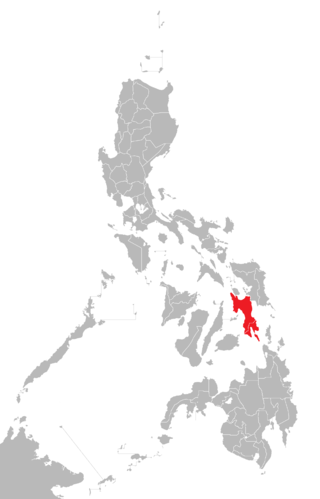
Leyte is an island in the Visayas group of islands in the Philippines. It is eighth-largest and sixth-most populous island in the Philippines, with a total population of 2,626,970 as of 2020 census.

Leyte, officially the Province of Leyte, is a province in the Philippines located in the Eastern Visayas region occupying the northern three-quarters of Leyte Island. Its capital is the city of Tacloban, administered independently from the province, as well as the regional center of Eastern Visayas. Leyte is thus north of Southern Leyte, south of Biliran, and west of Samar Island. To the west across the Camotes Sea is the province of Cebu.

Samar, officially the Province of Samar, or also known named as Western Samar, is a province in the Philippines located in the Eastern Visayas region. Its capital is the city of Catbalogan while Calbayog is the most populous city in the province. It is bordered by Northern Samar, Eastern Samar, Leyte and Leyte Gulf, and includes several islands in the Samar Sea. Samar is connected to the island of Leyte via the San Juanico Bridge.

Maasin, officially the City of Maasin, is a component city and capital of the province of Southern Leyte, Philippines. According to the 2020 census, it has a population of 87,446 people.

Sogod, officially the Municipality of Sogod, is a municipality in the province of Southern Leyte, Philippines. According to the 2020 census, it has a population of 47,552 people.

The Roman Catholic Diocese of Calbayog is an ecclesiastical territory of the Catholic Church named after its episcopal see, Calbayog, a city on the western side of the province of Samar in the Philippines.

The Diocese of Borongan is a Latin Church ecclesiastical jurisdiction or diocese of the Catholic Church in the Philippines. Created on October 22, 1960 by Pope John XXIII from territory of the Diocese of Calbayog, the diocese is a suffragan in the ecclesiastical province of the metropolitan Archdiocese of Palo.

The Roman Catholic Diocese of Maasin is a diocese of the Latin Church of the Catholic Church in the Philippines, comprising the civil province of Southern Leyte and six municipalities from the fifth legislative district of Leyte. Erected in 1968, the diocese was erected from the Archdiocese of Palo. At present, the diocese has experienced no jurisdictional changes, and is a suffragan of the Archdiocese of Cebu. The current bishop is Precioso D. Cantillas, appointed in 1998.

John Forrosuelo Du, is a prelate of the Catholic Church in the Philippines. He is the Archbishop of Palo in Leyte, Philippines. He was appointed to a previously vacant see left with the appointment of archbishop Jose S. Palma to the Archdiocese of Cebu.

The National Shrine and Cathedral Parish of Our Lady of the Assumption, commonly known as Maasin Cathedral, is a baroque Roman Catholic church in Maasin City, Southern Leyte, Philippines. It is the seat of the Diocese of Maasin.

The Leyte Provincial Board is the Sangguniang Panlalawigan of the Philippine province of Leyte.
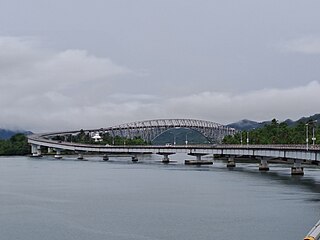
Eastern Visayas is an administrative region in the Philippines, designated as Region VIII. It consists of three main islands: Samar, Leyte, and Biliran. The region has six provinces: Biliran, Leyte, Northern Samar, Samar, Eastern Samar, Southern Leyte, one independent city, Ormoc, and one highly urbanized city, Tacloban. The highly urbanized city of Tacloban is the sole regional center. These provinces and cities occupy the easternmost islands of the Visayas group of islands, hence the region's name. Some historians believe that the oldest ancient kingdom in the Philippines is found in this region, the Lakanate of Lawan, which plays a significant role in the Polynesian and Austronesian intermigration.
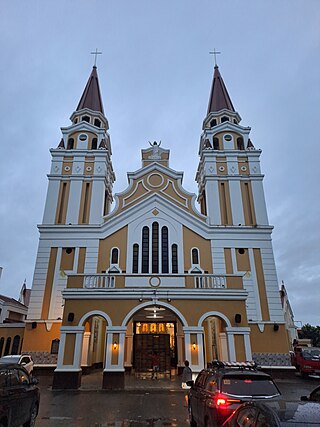
The Metropolitan Cathedral of Our Lord's Transfiguration, also known as Transfiguration of Our Lord's Cathedral or simply Palo Cathedral, is a Roman Catholic church located at Palo, Leyte, in the Philippines belonging to the Vicariate of Palo under the Metropolitan Archdiocese of Palo.
The COVID-19 pandemic in Eastern Visayas is part of the worldwide pandemic of coronavirus disease 2019 caused by severe acute respiratory syndrome coronavirus 2. The virus reached Eastern Visayas on March 23, 2020, when the first case of the disease was confirmed in Northern Samar.

Leyte's 1st congressional district is one of the five congressional districts of the Philippines in the province of Leyte. It has been represented in the House of Representatives of the Philippines since 1916 and earlier in the Philippine Assembly from 1907 to 1916. The district consists of the provincial capital, Tacloban, and adjacent municipalities of Alangalang, Babatngon, Palo, San Miguel, Santa Fe, Tanauan and Tolosa since 1987. It is currently represented in the 19th Congress by Martin Romualdez of the Lakas–CMD (Lakas), who has served as the House Speaker since July 2022.

Leyte's 2nd congressional district is one of the five congressional districts of the Philippines in the province of Leyte. It has been represented in the House of Representatives of the Philippines since 1916 and earlier in the Philippine Assembly from 1907 to 1916. The district consists of the central municipalities of Barugo, Burauen, Capoocan, Carigara, Dagami, Dulag, Jaro, Julita, La Paz, MacArthur, Mayorga, Pastrana, Tabontabon and Tunga since its second restoration in 1987. It is currently represented in the 19th Congress by Lolita Javier of the Nacionalista Party (NP).

Leyte's 4th congressional district is one of the five congressional districts of the Philippines in the province of Leyte. It has been represented in the House of Representatives of the Philippines since 1916 and earlier in the Philippine Assembly from 1907 to 1916. The district consists of the city of Ormoc and adjacent municipalities of Albuera, Isabel, Kananga, Matag-ob, Merida and Palompon since 1987. It is currently represented in the 19th Congress by Richard Gomez of the Partido Federal ng Pilipinas (PFP).
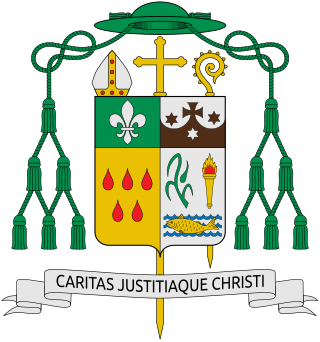
Angel Tec-i Hobayan was a Filipino bishop of the Roman Catholic Church. He was the first Bishop of Catarman from 1974 to 2005.






























